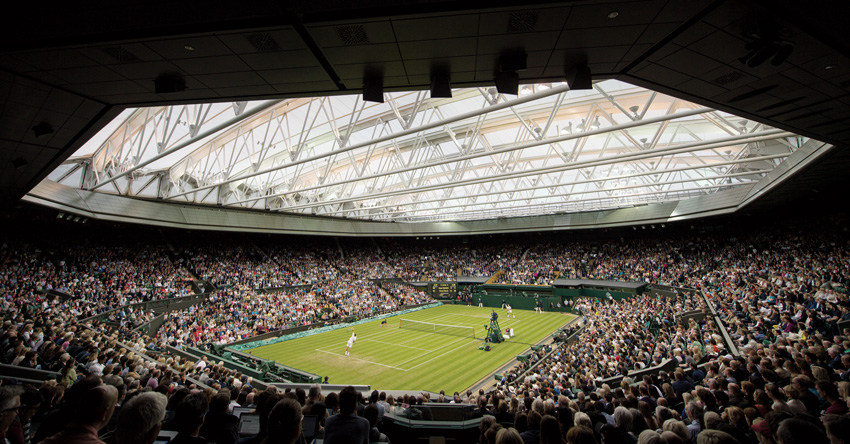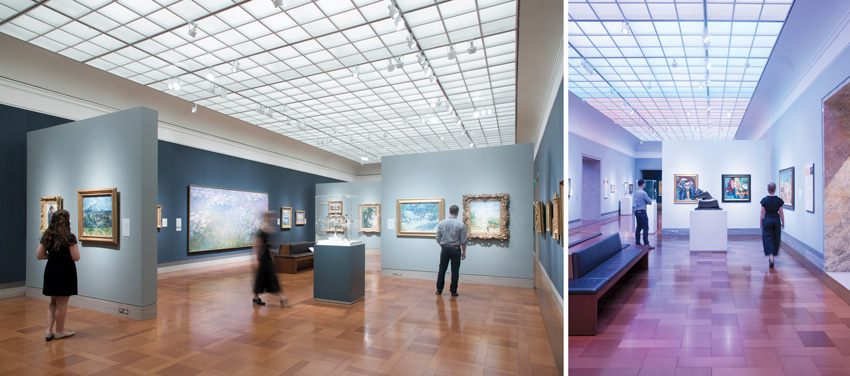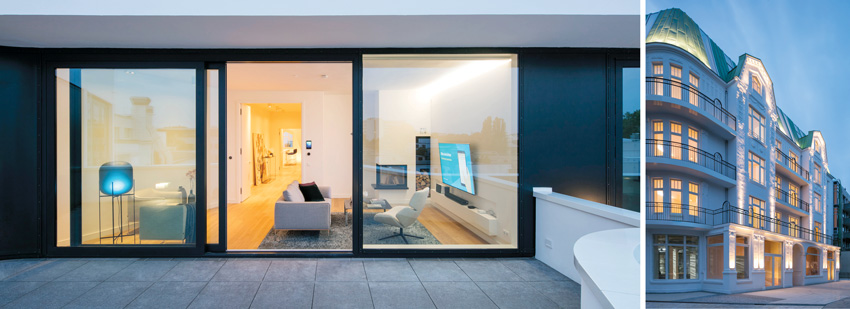Lighting Controls
At the same time that the lighting industry is moving toward increasingly integrated and interoperable systems, a new layer of luminaire connectivity is poised to have an effect on the built environment. As part of the growing phenomenon commonly referred to as the Internet of Things (IoT), manufacturers are beginning to embed light fixtures and even LED modules with smart sensors that measure conditions such as light levels, occupancy, temperature, and energy use. These communicate wirelessly and respond to distant and local commands, delivering data directly to facility managers as well as individuals at workstations, visitors to museums, even consumers at supermarkets and big-box stores.
These IoT capabilities present new possibilities for outdoor lighting systems at the urban scale. Manufacturers such as Philips and Current by GE offer connected lighting that goes well beyond turning streetlamps on or off. For instance, Philips is working with the city of Los Angeles and has outfitted its light poles with sensors that allow municipal managers to track energy use, determine if a particular lamp needs maintenance, and monitor grid health by detecting power fluctuations or surges. Some of the functionality has little to do with illumination: in September, the company completed a pilot installation of acoustic-sensing modules on 30 of LA’s streetlights. Susanne Seitinger, leader of Philips’s Global Smart Cities division, explains that the sensors process, map, and analyze peaks and averages rather than record sound. Some of the potential benefits are faster emergency response times after a car crash, or the ability to monitor noise pollution.
Many major LED manufacturers have already developed or are working on similarly “intelligent” lighting for building interiors, where a network of lighting fixtures can serve as the backbone for an indoor positioning system (IPS). Such networks, which pick up where global positioning systems (GPS) leave off, are being used in a number of different building types, including chain retailers like Walgreens, Toys“R”Us, and Target. IPS takes advantage of the ubiquity of lighting within stores, and can work in a number of ways. But often it communicates with shoppers’ smartphones via Bluetooth beacons integrated into the LED lamps or with visible light communication (VLC), which capitalizes on LEDs’ inherent flicker. These positioning technologies can help customers navigate the aisles and locate specific products and allow retailers to track inventory, notify customers of special promotions, and understand which areas of a store are most popular. The ultimate goal is, of course, to increase sales.
While sophisticated controls can certainly help an owner’s bottom line, architects and lighting professionals increasingly see such systems as a means of enhancing the quality of a space and the occupants’ experience of it. One example is the use of tunable-white LEDs. These lamps, which have color temperatures that range from warm to cool, can help regulate the body’s circadian rhythm (its internal clock), making people feel more alert during the day and sleep more soundly at night. The success of such lighting schemes depends on the amount and duration of exposure, color, and especially timing, points out Mariana Figueiro, the program director of the Lighting Research Center (LRC) at Rensselaer Polytechnic Institute in Troy, New York. “For the circadian system, the same light given at the wrong time will have negative effects, while at the right time it will be beneficial,” she explains. “That’s where advanced controls can play a major role.”
Figueiro sees the greatest potential for circadian applications in facilities that operate around the clock such as hospitals, nursing homes, and prisons. But these applications are also finding their way into the workplace (see page 113). Even the General Services Administration (GSA), which owns and leases more than 376.9 million square feet in 9,600 buildings, could adopt circadian lighting. With the help of the LRC, the agency has been studying the effects of both daylight and electric illumination on circadian rhythms in a variety of its buildings. The investigations, which combined photometric measurements with occupant questionnaires, attempt to quantify the relationship between certain kinds of light and alert-ness, mood, and sleep quality. The project could shape the way the agency designs and renovates buildings. “The goal is to make evidence-based changes to our [construction] guidance documents,” says Bryan Steverson, a GSA high-performance-building program advisor.
If owners with holdings as extensive as the GSA’s were to embrace the capabilities of the latest lamp technologies and harness the potential of intelligent systems, the use of connected controls and their integration into the still nascent Internet of Things could soon become mainstream, say industry sources. “As long as we get the level of technology right, drive down the price, and get people to accept its security and reliability,” says Bokelman of IES, “we will create a platform that will carry us into the future—one that won’t be made irrelevant because it’s ‘just a light.’”













